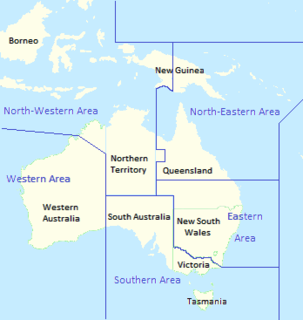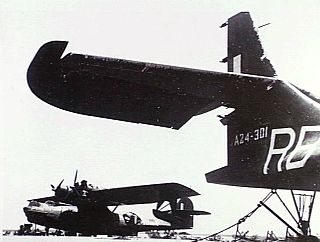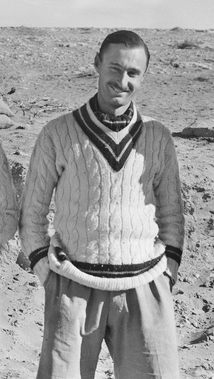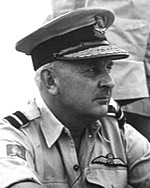This is a list of the wings organised by the Royal Australian Air Force (RAAF).
Information Warfare Directorate – centralises the AF’s tactical information warfare elements and provides the wider RAAF with an integrated and tailorable operational support capability drawn from across the Intelligence, Electronic Warfare and Information Operations domains.

No. 75 Squadron is a Royal Australian Air Force (RAAF) fighter unit based at RAAF Base Tindal in the Northern Territory. The squadron was formed in 1942 and saw extensive action in the South West Pacific theatre of World War II, operating P-40 Kittyhawks. It was disbanded in 1948, but reformed the following year and operated jet aircraft throughout the Cold War. The squadron was based at Malta from 1952 to 1954, flying de Havilland Vampires, and Malaysia from 1968 to 1983, with Dassault Mirage IIIs, before returning to Australia.

No. 20 Squadron is a Royal Australian Air Force (RAAF) support squadron. Coming under the control of No. 96 Wing, it is responsible for the management of the airfield at RAAF Base Woomera, South Australia. The squadron originated as a maritime patrol unit during World War II. Raised in August 1941, it operated PBY Catalina and Short Empire flying boats from bases in New Guinea, Queensland and the Northern Territory, conducting search-and-rescue, mine-laying, anti-submarine and bombing missions against Japanese targets in the Pacific theatre. Following the conclusion of hostilities, the squadron was disbanded in March 1946. It was reactivated as an airfield support squadron in April 2015.

No. 81 Wing is responsible for operating the McDonnell Douglas F/A-18 Hornet multi-role fighters of the Royal Australian Air Force (RAAF). Headquartered at RAAF Base Williamtown, New South Wales, the wing comprises three combat units, Nos. 3 and 77 Squadrons based at Williamtown and No. 75 Squadron at RAAF Base Tindal, Northern Territory, as well as an operational conversion unit at Williamtown. No. 81 Wing headquarters oversees squadron training in air-to-air and air-to-ground tactics, and support for the Australian Army and Royal Australian Navy. Tasked with offensive and defensive counter-air operations, the Hornets have been deployed to Diego Garcia in 2001–02, when they provided local air defence, to Iraq in 2003, when they saw action flying fighter escort and close air support missions in concert with Coalition forces, and to the Middle East in 2015–16, when they undertook strike operations during the military intervention against ISIL. They have also been employed to patrol high-profile events in Australia, including the Commonwealth Games and visits by foreign dignitaries.

No. 82 Wing is the strike and reconnaissance wing of the Royal Australian Air Force (RAAF). It is headquartered at RAAF Base Amberley, Queensland. Coming under the control of Air Combat Group, the wing operates F/A-18F Super Hornet multirole fighters and Pilatus PC-21 forward air control aircraft. Its units include Nos. 1 and 6 Squadrons, operating the Super Hornet, and No. 4 Squadron, operating the PC-21.

North-Eastern Area Command was one of several geographically based commands raised by the Royal Australian Air Force (RAAF) during World War II. For most of its existence it controlled units based in central and northern Queensland as well as Papua New Guinea. It was formed in January 1942 from the eastern part of the former Northern Area Command, which had covered all of northern Australia and Papua. Headquartered at Townsville, Queensland, North-Eastern Area Command's responsibilities included air defence, aerial reconnaissance and protection of the sea lanes within its territory. Its flying units, equipped with fighters, reconnaissance bombers, dive bombers and transports, took part in the battles of Rabaul, Port Moresby and Milne Bay in 1942, and the landings at Hollandia and Aitape in 1944.

Air Marshal Sir Charles Frederick Read, KBE, CB, DFC, AFC was a senior commander in the Royal Australian Air Force (RAAF). He served as Chief of the Air Staff (CAS) from 1972 to 1975. Born in Sydney, Read joined the RAAF in 1937, and began his career flying biplane fighters. As a Beaufighter pilot, he led No. 31 Squadron and No. 77 Wing in the South West Pacific during World War II. His achievements earned him the Distinguished Flying Cross and a mention in despatches, and he finished the war an acting group captain.

No. 71 Wing was a Royal Australian Air Force (RAAF) wing of World War II. It was formed in February 1943 at Milne Bay, Papua New Guinea, as part of No. 9 Operational Group. The wing initially comprised two squadrons of P-40 Kittyhawks, one of Lockheed Hudsons, and one of Bristol Beauforts. The wing's mainstay soon became the Beaufort, which eventually equipped five squadrons attached to the formation. No. 71 Wing took part in the New Guinea campaign under the auspices of No. 9 Group, before transferring to No. 10 Operational Group for the Western New Guinea campaign during 1944. It then returned to the control of Northern Command to support Australian ground forces in the Aitape–Wewak campaign, and completed its final combat mission only hours before the Japanese surrender in August 1945. No. 71 Wing remained in New Guinea following the war and was disbanded in January 1946.

No. 73 Wing was a Royal Australian Air Force (RAAF) wing of World War II. It was formed in February 1943 at Port Moresby, Papua New Guinea, as part of No. 9 Operational Group. The wing initially comprised three attack squadrons flying CAC Wirraways, Douglas Bostons, and Bristol Beaufighters, with which it took part in the New Guinea campaign until mid-year. It was then reorganised with three fighter squadrons operating P-40 Kittyhawks and Supermarine Spitfires; in this form it saw action in the New Britain and Admiralty Islands campaigns through 1943–44. The wing was disbanded at Los Negros in August 1944, and by the beginning of 1945 its squadrons had been absorbed into other RAAF wings under No. 10 Operational Group.

No. 77 Wing was a Royal Australian Air Force (RAAF) wing of World War II. It formed part of No. 10 Operational Group at its establishment in November 1943, when it comprised three squadrons equipped with Vultee Vengeance dive bombers. No. 77 Wing commenced operations in early 1944, flying out of Nadzab, Papua New Guinea. Soon afterwards, however, the Vengeance units were withdrawn from combat and replaced with squadrons flying Douglas Bostons, Bristol Beaufighters and Bristol Beauforts. The wing saw action in the assaults on Noemfoor, Tarakan, and North Borneo, by which time it was an all-Beaufighter formation made up of Nos. 22, 30 and 31 Squadrons. It was to have taken part in the Battle of Balikpapan in June 1945, but unsuitable landing grounds meant that the Beaufighter units were withdrawn to Morotai, sitting out the remainder of the war before returning to Australia, where they disbanded, along with the wing headquarters, in 1946.

No. 76 Wing was a Royal Australian Air Force (RAAF) wing that operated during World War II. Initially based in Far North Queensland, its headquarters transferred to Darwin, Northern Territory, in September 1944 to take control of three PBY Catalina units: Nos. 20, 42, and 43 Squadrons. The prime task of these squadrons was minelaying in the South West Pacific theatre, and they conducted these operations as far afield as Java, Borneo, the Philippines, and China. As well as minelaying, No. 76 Wing's Catalinas flew bombing, patrol, and transport missions, and dropped millions of propaganda leaflets in the closing months of the war. The wing headquarters disbanded in November 1945.

Air Vice Marshal Ian Dougald McLachlan, CB, CBE, DFC was a senior commander in the Royal Australian Air Force (RAAF). Born in Melbourne, he was a cadet at the Royal Military College, Duntroon, before joining the Air Force in December 1930. After serving in instructional and general flying roles, he took command of No. 3 Squadron in December 1939, leading it into action in the Middle East less than a year later. Awarded the Distinguished Flying Cross, he returned to Australia in 1942 to command air bases in Canberra and Melbourne. The following year he was posted to the South West Pacific, where he led successively Nos. 71 and 73 Wings. Having been promoted to group captain, he took charge of Southern Area Command in 1944, and No. 81 Wing in the Dutch East Indies the following year.

Air Commodore Gordon Henry Steege, DSO, DFC was a senior officer in the Royal Australian Air Force (RAAF). He became a fighter ace in World War II, credited with eight aerial victories. Joining the RAAF in July 1937, Steege first saw action with No. 3 Squadron in the Middle East, where he was awarded the Distinguished Flying Cross after shooting down three German aircraft in a single sortie. He rose to command No. 450 Squadron in the Desert Air Force, before being posted to the South West Pacific, where he led Nos. 73 and 81 Wings. He earned the Distinguished Service Order for his "outstanding leadership", and finished the war a temporary group captain.

RAAF Command was the main operational arm of the Royal Australian Air Force (RAAF) during World War II. The command was formed in September 1942 and by April 1943 comprised 27 squadrons, including units from the Netherlands, the United Kingdom and the United States, as well as Australia. Coming under the operational authority of Allied Air Forces Headquarters in the South West Pacific Area, RAAF Command exercised control of its units through geographically based area commands in Australia and, later, New Guinea, as well as large mobile formations including the Australian First Tactical Air Force. The command reached a strength of 41 squadrons in October 1944. From the time of its establishment, until its disbandment in September 1945, it was led by Air Vice Marshal Bill Bostock.

Air Vice Marshal Alan Moorehouse Charlesworth, CBE, AFC was a senior commander in the Royal Australian Air Force (RAAF). Born in Tasmania, he graduated from the Royal Military College, Duntroon, and served with the 2nd Light Horse Regiment in Queensland before transferring to the Air Force in 1925. Most of his pre-war flying career was spent with No. 1 Squadron at RAAF Station Laverton, Victoria. In 1932 he undertook a series of survey flights around Australia, earning the Air Force Cross. Charlesworth's early wartime commands included No. 2 Squadron at Laverton, and RAAF Station Pearce in Western Australia. Appointed Air Officer Commanding (AOC) Eastern Area in December 1943, he was promoted temporary air commodore the following year and took over as AOC North-Western Area in Darwin, Northern Territory.

Eastern Area Command was one of several geographically based commands raised by the Royal Australian Air Force (RAAF) during World War II. It was formed in May 1942, and controlled units located in New South Wales and southern Queensland. Headquartered in Sydney, Eastern Area Command's responsibilities included air defence, aerial reconnaissance and protection of the sea lanes within its boundaries. Its flying units operated fighters, reconnaissance bombers, and dive bombers, and concentrated on convoy escort, maritime patrol and anti-submarine warfare. The size of the area was such that the RAAF twice considered splitting it, but nothing came of this.

Northern Command was one of several geographically based commands raised by the Royal Australian Air Force (RAAF) during World War II. Established in April 1944, it evolved from No. 9 Operational Group, which had been the RAAF's primary mobile formation in the South West Pacific theatre since September 1942, but had lately become a garrison force in New Guinea. Northern Command was headquartered initially at Milne Bay and then, from August 1944, in Madang. It conducted operations in New Guinea, New Britain, and Bougainville until the end of the war. Re-designated Northern Area in December 1945, it was headquartered in Port Moresby from March 1946 and disbanded in February 1947.

Western Area Command was one of several geographically based commands raised by the Royal Australian Air Force (RAAF) during World War II. It was formed in January 1941, and controlled RAAF units located in Western Australia. Headquartered in Perth, Western Area Command was responsible for air defence, aerial reconnaissance and protection of the sea lanes within its boundaries. Its aircraft conducted anti-submarine operations throughout the war, and attacked targets in the Dutch East Indies during the Borneo campaign in 1945.

Area commands were the major operational and administrative formations of the Royal Australian Air Force (RAAF) between 1940 and 1954. Established in response to the outbreak of World War II, they underpinned the Air Force's geographically based command-and-control system for the duration of the conflict and into the early years of the Cold War, until being superseded by a functional control system made up of Home, Training, and Maintenance Commands.

Southern Area Command was one of several geographically based commands raised by the Royal Australian Air Force (RAAF) during World War II. It was formed in March 1940, and initially controlled units located in Victoria, Tasmania, South Australia and southern New South Wales. Headquartered in Melbourne, Southern Area Command was responsible for air defence, aerial reconnaissance and protection of the sea lanes within its boundaries. From 1942 its operational responsibilities excluded New South Wales.

North-Western Area Command was one of several geographically based commands raised by the Royal Australian Air Force (RAAF) during World War II. Its wartime sphere of operations included the Northern Territory, adjacent portions of Queensland and Western Australia, and the Dutch East Indies. The command was formed in January 1942, following the outbreak of the Pacific War, from the western part of Northern Area Command, which had covered all of northern Australia and Papua. Headquartered at Darwin, North-Western Area Command was initially responsible for air defence, aerial reconnaissance and protection of the sea lanes within its boundaries.